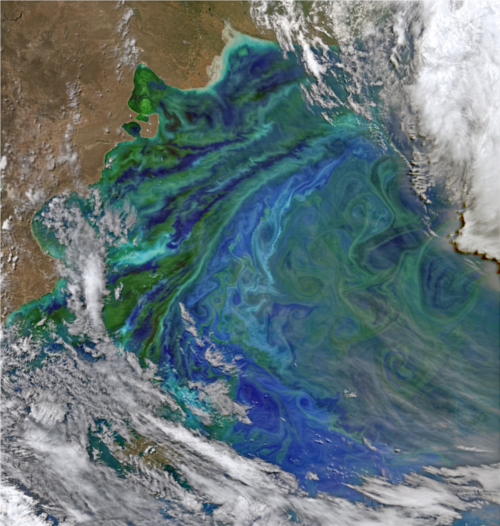story by Helen Hill

This month we focus on work by Hajoon Song, John Marshall, Stephanie Dutkiewicz, Mick Follows and Gael Forget from MIT who have been using MITgcm to explore nutrient sources for the Patagonia Shelf Region. The Patagonian Shelf, located in the southwest Atlantic ocean, is one of the regions biggest CO2 sinks due to locally high productivity. Song has been investigating the nutrient sources that support the Patagonian shelf ecosystem using an adjoint sensitivity analysis with passive tracers. This computationally efficient method reveals three major nutrient sources: local area, Chilean coastal area and deep southeast Pacific. It also shows that wintertime vertical mixing is one of the key processes to deliver nutrients to the Patagonian shelf region.

Source waters (shaded blue) and mixed layer depth (red line) on 7 months before, 5 months before, 3 months before and 1 month before – image credit: H. Song
The Patagonian Shelf is a highly productive marine ecosystem extending down the west coast of the South Atlantic from Uruguay to the Strait of Magellan. With a total area of about 2.7 million square kilometers, the continental shelf is relatively narrow in the north widening progressively to the south, where it reaches a width of around 850 kilometers. Paired with this bathymetry key players in the circulation are two major wind-driven currents: the northward flowing Falklands/Malvinas Current and the southward flowing Brazil Current. Together these delineate a distinctive ecological boundary to the east.
While the southward flowing Brazil Current is warm and saline, the northward flowing Falklands/Malvinas Current carries cool, less saline, nutrient-rich sub-antarctic water towards the equator. The two currents mix at a Confluence Zone (CZ), a wide area characterized by intense horizontal and vertical mixing.
Exchange of water masses of different temperatures and salinity affects biological productivity but the characteristics and dynamics of the CZ have remained poorly understood.
Using MITgcm to perform a passive tracer adjoint sensitivity experiment, Song and co-authors identify three source waters: waters local to the Patagonian shelf, coastal waters near the Chilean coast and the subsurface waters in the southeast Pacific. The team then perform a series of forward simulations of MITgcm incorporating biogeochemistry to investigate the impact of nutrient perturbations in these source regions to productivity on the Patagonian shelf.

Hajoon Song has been using MITgcm since 2013. When not running MITgcm, Song enjoys doing LEGO with his with son.
Song et al report finding that positive nitrate perturbations from local waters have an immediate impact elevating productivity. Iron perturbations local to the shelf, however, do not change productivity because the shelf region is limited by nitrate. Additional nutrient supply from the other source regions leads to increases in productivity. They also found that positive nutrient perturbations in subsurface waters in the southeast Pacific result in the largest boost of productivity over the shelf. These source waters are rich in nutrients and upwell from the depth where light levels are so low that they cannot be consumed. Finally, the team identified wintertime intense vertical mixing as the key process which draws nutrients from below 300–500 m to the surface before delivery to the shelf.
To find out more about this work contact Hajoon
This Month’s Featured Publication
- Hajoon Song, John Marshall, Michael J. Follows, Stephanie Dutkiewicz, Gaël Forget (2016), Source waters for the highly productive Patagonian shelf in the southwestern Atlantic, Journal of Marine Systems, Available online 3 March 2016, doi:10.1016/j.jmarsys.2016.02.009
Other New Publications in March
Surendra Adhikari, Erik R. Ivins, and Eric Larour (2016), ISSM-SESAW v1.0: mesh-based computation of gravitationally consistent sea-level and geodetic signatures caused by cryosphere and climate driven mass change, Geosci. Model Dev., 9, 1087-1109, doi: 10.5194/gmd-9-1087-2016
L. Carrillo, E.M. Johns, R.H. Smith, J.T. Lamkin, J.L. Largier (2016), Pathways and hydrography in the Mesoamerican Barrier Reef System Part 2: Water masses and thermohaline structure, in press at Continental Shelf Research, Available online 16 March 2016, doi: 10.1016/j.csr.2016.03.014
Carsten Eden (2016), Closing the energy cycle in an ocean model, Ocean Modelling, Available online 26 February 2016, doi: 10.1016/j.ocemod.2016.02.005
Daniel Goldberg, Sri Hari Krishna Narayanan, Laurent Hascoet, and Jean Utke (2016), An optimized treatment for algorithmic differentiation of an important glaciological fixed-point problem., Geosci. Model Dev. Discuss., doi: 10.5194/gmd-2016-11, 2016 Manuscript under review for journal Geosci. Model Dev.
Shijian Hu and Janet Sprintall (2016), Interannual variability of the Indonesian throughflow: The salinity effect, Journal of Geophysical Research – Oceans, manuscript online: 18 March 2016, doi: 10.1002/2015JC011495
Madlen Kimmritz, Sergey Danilov, Martin Losch (2016), The adaptive EVP method for solving the sea ice momentum equation, Ocean Modelling, available online 24 March 2016, doi: 10.1016/j.ocemod.2016.03.004
A.V. Koldunov, N.V. Koldunov, D.L. Volkov, T.V. Belonenko (2016), Applying Satellite Data for Validation of the Hydrodynamic Model for the Arctic Ocean, CURRENT PROBLEMS IN REMOTE SENSING OF THE EARTH FROM SPACE, Russian Academy of Sciences, Space Research Institute RAS ISSN 2070-7401 (Print), ISSN 2411-0280 (Online), link
Xinfeng Liang and Lisan Yu (2016), Variations of the Global Net Air-Sea Heat Flux During the “Hiatus” Period (2001–2010), Journal of Climate 2016 ; e-View, doi: 10.1175/JCLI-D-15-0626.1
Magdalene N. Ngeve, Tom Van der Stocken, Dimitris Menemenlis, Nico Koedam, Ludwig Triest (2016), Contrasting Effects of Historical Sea Level Rise and Contemporary Ocean Currents on Regional Gene Flow of Rhizophora racemosa in Eastern Atlantic Mangroves, PLOS one, Published: March 10, 2016, doi: 10.1371/journal.pone.0150950
Lars Nerger (2016), The Parallel Data Assimilation Framework PDAF: Status and Future Developments. Paper presented at “Blueprints for Next-Generation Data Assimilation Systems”, 8-10 March 2016, Boulder, CO – link.
L. Resplandy, R. F. Keeling, B. B. Stephens, J. D. Bent, A. Jacobson, C. Rödenbeck, S. Khatiwala (2016), Constraints on oceanic meridional heat transport from combined measurements of oxygen and carbon, Climate Dynamics, First online: 27 February 2016, doi: 10.1007/s00382-016-3029-3
Fabio Di Sante, Erika Coppola, Riccardo Farneti, and Filippo Giorgi (2016), The ICTP Regional System Model (RESM) to simulate the monsoon in the South Asia CORDEX domain, Geophysical Research Abstracts
Vol. 18, EGU2016-5920-2, 2016, PDF
Hajoon Song, John Marshall, Michael J. Follows, Stephanie Dutkiewicz, Gaël Forget (2016), Source waters for the highly productive Patagonian shelf in the southwestern Atlantic, Journal of Marine Systems, Available online 3 March 2016, doi: 10.1016/j.jmarsys.2016.02.009
Gunnar Spreen, Ron Kwok, Dimitris Menemenlis, and An T. Nguyen (2016), Sea Ice Deformation in a Coupled Ocean-Sea Ice Model and in Satellite Remote Sensing Data, under review in The Cryosphere Discuss., doi: 10.5194/tc-2016-13
Zhongxiang Zhao, Matthew H. Alford, James B. Girton, Luc Rainville, Harper L. Simmons (2016), Global Observations of Open-Ocean Mode-1 M2 Internal Tides, Journal of Physical Oceanography, Published Online: 7 March, 2016, doi: 10.1175/JPO-D-15-0105.1
Do you have news about research using MITgcm? We are looking for contributions to these pages. If you have an interesting MITgcm project (ocean, atmosphere, sea-ice, physics, biology or otherwise) that you want to tell people about, get in touch. To make a post, contact Helen

